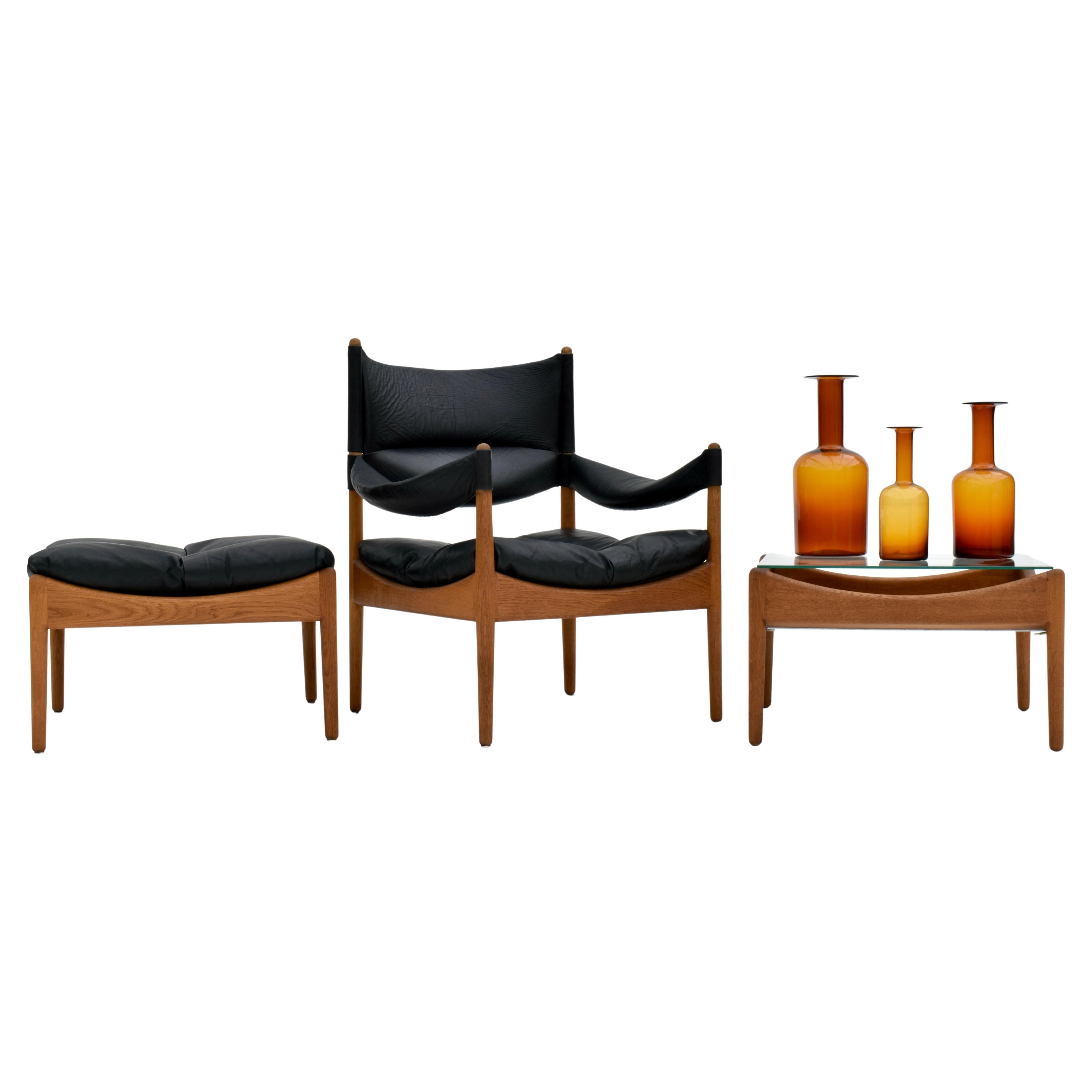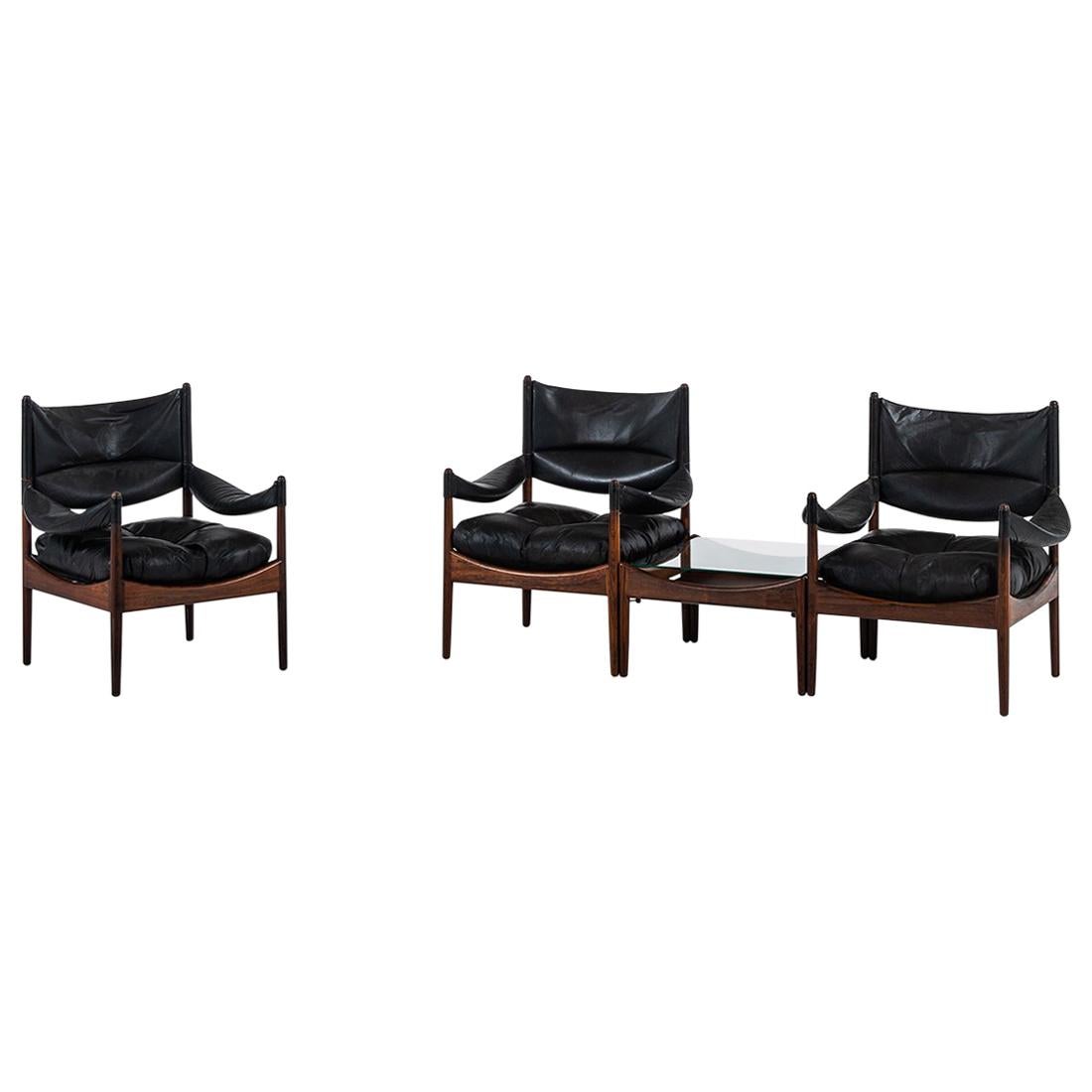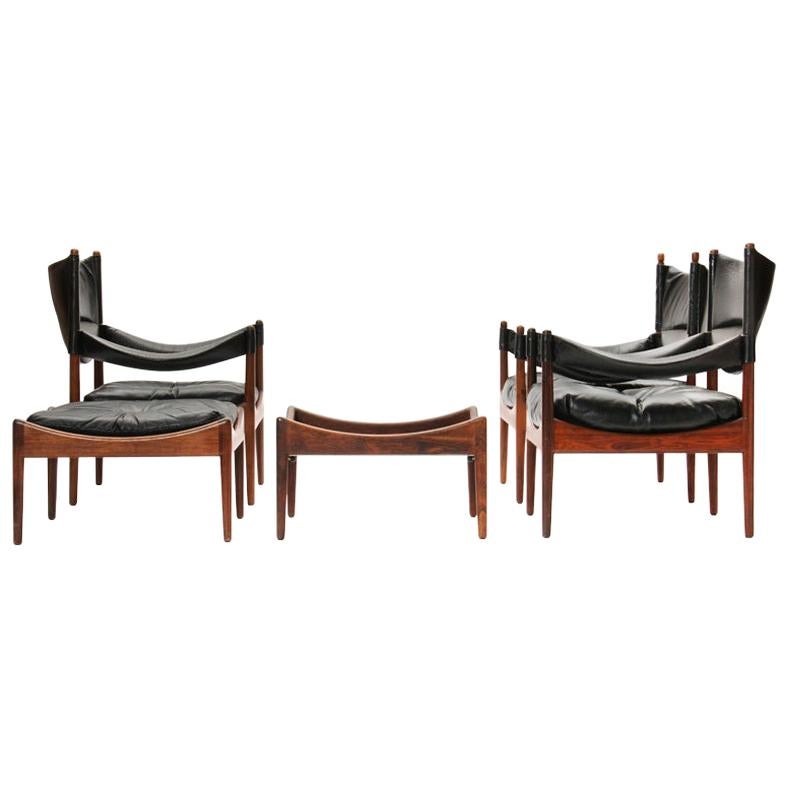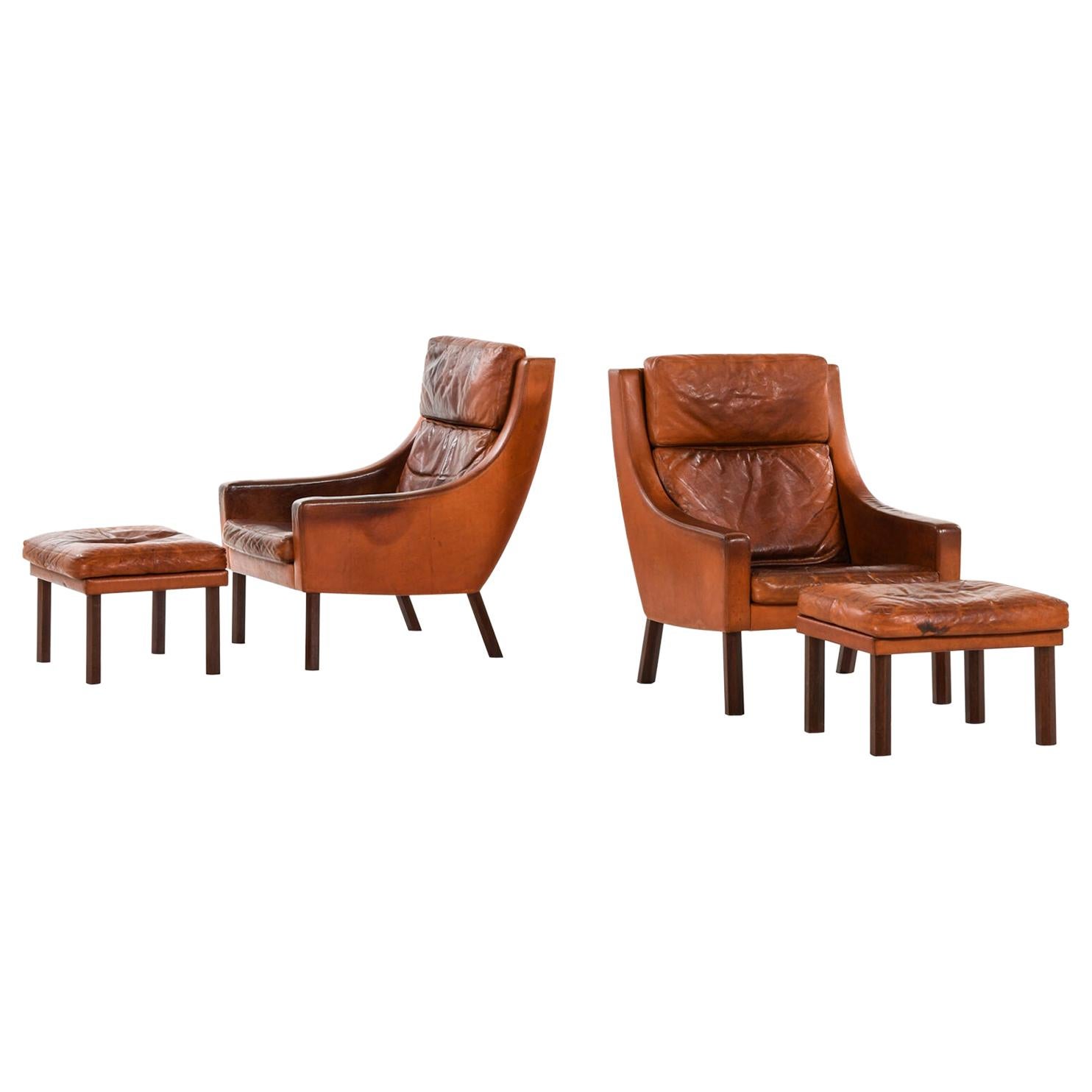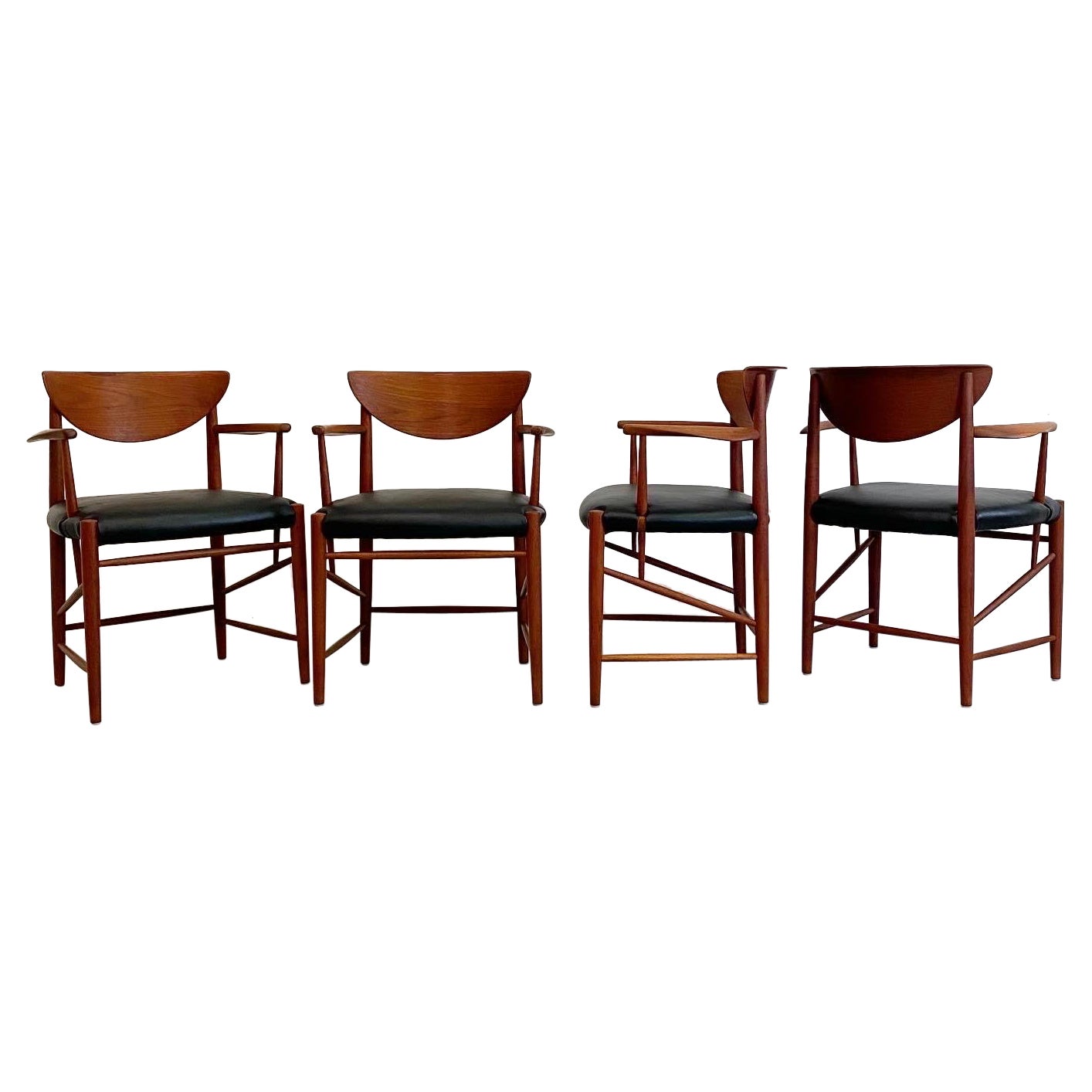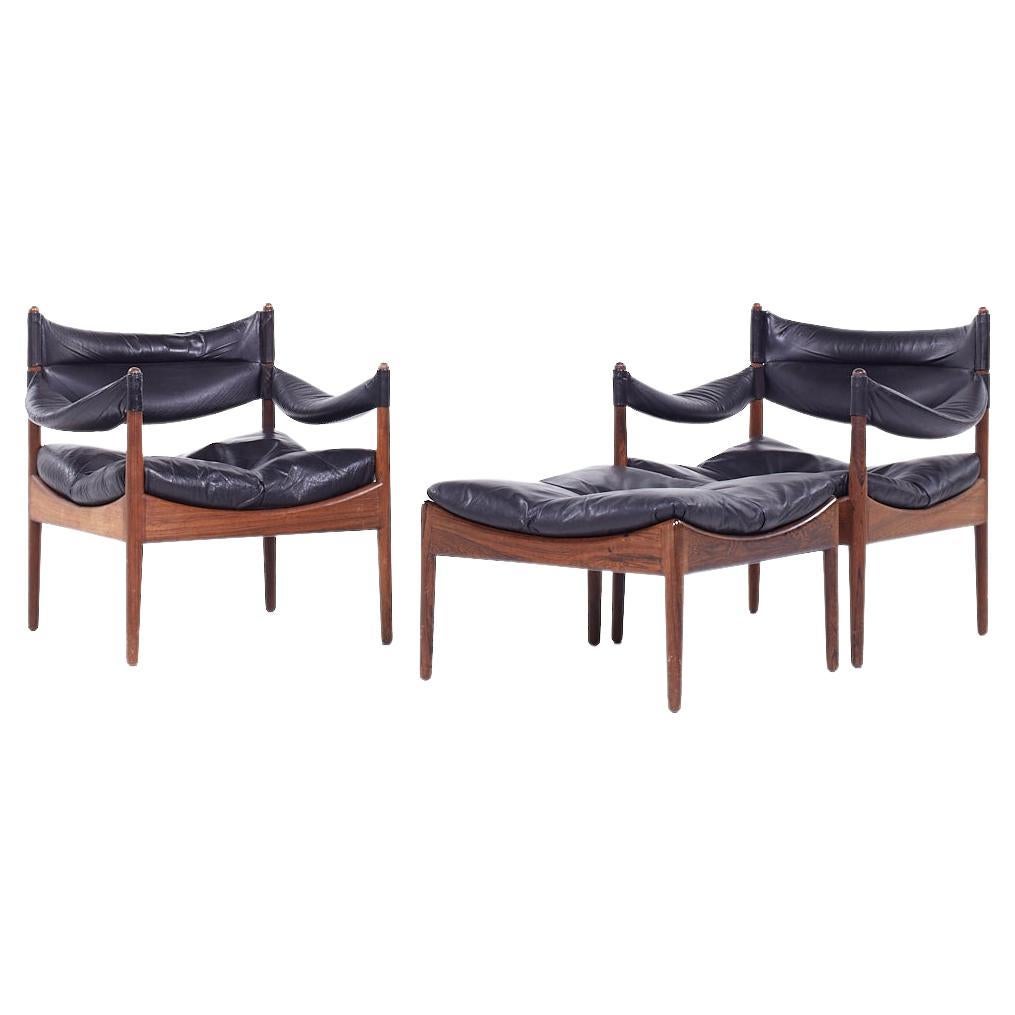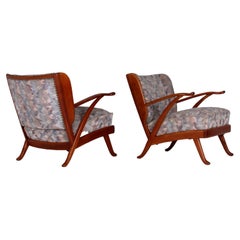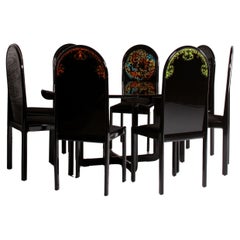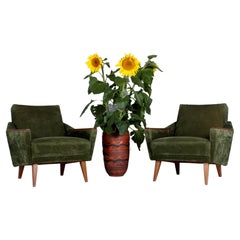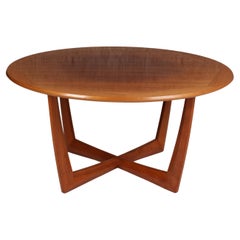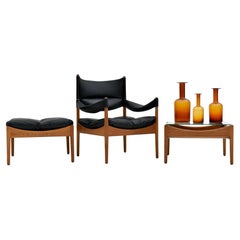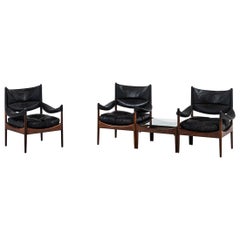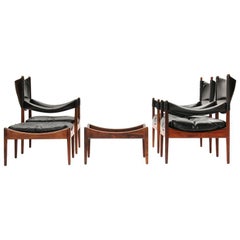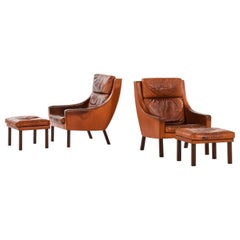Items Similar to MODUS by Kristian Solmer Vedel SET of 3 lounge chairs 1 stool & 2 coffee tables
Want more images or videos?
Request additional images or videos from the seller
1 of 21
MODUS by Kristian Solmer Vedel SET of 3 lounge chairs 1 stool & 2 coffee tables
$11,727.69per set
£8,711.71per set
€9,800per set
CA$16,179.16per set
A$17,785.35per set
CHF 9,347.17per set
MX$215,978.97per set
NOK 116,603.55per set
SEK 110,473.66per set
DKK 74,602.68per set
About the Item
This set was designed by Kristian Solmer Vedel for the renowned Søren Willadsen Møbelfabrik in Denmark.
It boasts excellent original condition.
The set includes two lounge armchairs and a lounge armchair with a high backrest and an upholstered stool,
which can also be used as a footrest.
From a beautifully crafted and impressively sturdy tropical timber frame, a lightweight mesh serves as the seat straps, cradling supple and gracefully tufted leather cushions filled with goose down for optimal comfort and flexibility.
Two coffee tables with their removable original brushed aluminum table tops complete this exceptional set.
Kristian Solmer Vedel was a Danish industrial designer who made a significant impact in the field. Born on March 2, 1923, and passing away on March 5, 2003, Vedel's legacy continues to inspire and shape the world of design. He completed his carpenter apprenticeship in 1942. From 1944 to 1945, he was a guest student of Professor Kaare Klint at the furniture department of the Royal Academy of Fine Arts in Copenhagen. In 1946, he graduated from the Department of Furniture Design at the School of Arts, Crafts and Design in Copenhagen, where he also lectured from 1953 to 1956. From 1947 to 1949, he served as Chairman of the Danish Furniture Designers. He was the driving force behind the establishment of the Industrial Designers of Denmark and served as the inaugural chairman of the association from 1966 to 1968. His work is unmistakably shaped by the German Bauhaus style.
Kristian Vedel organized and headed the Department of Industrial Design at the University of Nairobi in Kenya between 1968 and 1971.
He and his wife Ane returned to Denmark in 1972 to open a design studio on Thyholm in northwest Jutland. On Thyholm, Kristian Vedel devoted most of his time to cultivating the surrounding landscape, breeding Shropshire sheep, and researching the use of their wool, hides, and meat.
Shipping ::
I'd be more than happy to offer you the most competitive shipping option if you just provide me with your postcode!
For the fastest and most secure shipping, your item will be shipped by air freight and packed in a custom-made wooden OSB board box (120cm x 80 cm x 140cm high) on pallet DAP (Delivery At Place).
- Creator:Kristian Solmer Vedel (Designer)
- Dimensions:Height: 30.32 in (77 cm)Width: 28.35 in (72 cm)Depth: 25.2 in (64 cm)Seat Height: 14.97 in (38 cm)
- Sold As:Set of 6
- Style:Scandinavian Modern (Of the Period)
- Materials and Techniques:
- Place of Origin:
- Period:
- Date of Manufacture:1960s
- Condition:in very good condition.
- Seller Location:Landshut, DE
- Reference Number:1stDibs: LU8587242440792
About the Seller
5.0
Vetted Professional Seller
Every seller passes strict standards for authenticity and reliability
1stDibs seller since 2023
21 sales on 1stDibs
- ShippingRetrieving quote...Shipping from: Bodenkirchen , Germany
- Return Policy
Authenticity Guarantee
In the unlikely event there’s an issue with an item’s authenticity, contact us within 1 year for a full refund. DetailsMoney-Back Guarantee
If your item is not as described, is damaged in transit, or does not arrive, contact us within 7 days for a full refund. Details24-Hour Cancellation
You have a 24-hour grace period in which to reconsider your purchase, with no questions asked.Vetted Professional Sellers
Our world-class sellers must adhere to strict standards for service and quality, maintaining the integrity of our listings.Price-Match Guarantee
If you find that a seller listed the same item for a lower price elsewhere, we’ll match it.Trusted Global Delivery
Our best-in-class carrier network provides specialized shipping options worldwide, including custom delivery.More From This Seller
View AllMidcentury set of 2 solid cherry wood wingback armchairs & sofa Karl Nothhelfer
Located in Landshut, BY
just beautiful
SET of Sofa & 2 Wingback Armchairs
by Prof. Karl Nothelfer - Designed in 1957
maker: Schörle & Gölz in Stuttgart - Bad Cannstatt
solid Cherry Wood
new upholstery and fabrics in 1998 according to last owner ( since then just in use for 2 years so upholstery is perfect ! )
Seatrests can be removed - and fixed by clips on belts
- high class -
measurements:
easy chair is 70cm wide ~ sofa is 178cm wide
both: seating height 40cm ~ seating depth: 57cm
condition - all firm and in very good condition - no damages
furniture have fully been accurately cleaned ::
- 3 steps: A: air pistol - B: industrial hoover - C: latest Kärcher "wash&hoover" technology
- woods have been polished several times
note: please ask for shipping quote by sending us your postcode/destination
Prof. Karl Nothelfer
* 14 June 1900 ~~ + 20 May 1980
Since the beginning of the 15th century, the Nothelfer family of carpenters has been continuously resident in the former
town of Überlingen without interruption. Every carpenter at that time mastered
all the possibilities of woodworking: so did the Nothelfer. They could carpenter,
even carve altars and figures, and set them in gold, silver and paint.
(churches in Owingen and Hödingen]. Some family members lived and worked
and worked in Hedingen or Hödingen,like today the jubilarian Karl Nothelfer (this in 1975).
His father, Karl Anton Nothelfer, as the eldest of seven siblings, was able to take over his father's carpentry business in Überlingen.
Karl Anton Nothelfer, the eldest of seven siblings, was unable to take over his father's carpentry business in Überlingen.
He instead moved to the industrial town of Singen with his young wife Rosalie, née Hanner, from the
from Hohenzollern in 1896 and moved to the former Poststraße and founded his own carpenter's workshop.
He had a highsense of quality and form and was already a member of the German Werkbund before 1914.
Karl Nothelfer and his three siblings grew up in such air.
After attending school and the secondary school in Singen, the young Karl learned the carpenter's trade in his father's workshop then moved on to the Badische Landes-Kunstschule in Karlsruhe,
where he studied architecture. At that time the well-known furniture professor also worked there
Fritz Spannagel, born in Freiburg in 1891, who settled in 1938 at Ittendorf Castle near Meers-
burg (died 1957). In 1928, the gifted young architect received a teaching assignment at the
at the Karlsruhe School of Art, but followed his teacher Spannagel to Berlin in the same year.
Berlin. Here he worked from 1928-1945 as a teacher - appointed professor in 1931 - at the
Berlin Tischler-Schule, the later Bauschule für Raumgestaltung.
The furniture he created in Berlin became internationally known through many exhibitions and lectures.
nationally known and influential. His furniture creations ushered in a new era in German and
a new era in German and European furniture design. At the world exhibition in Paris
1937 Prof. Nothelfer was awarded the Golden Medal for his work in the furniture sector.
for his work in the furniture sector. A first summary and balance of his work on furniture is given in his standard work
1942 published standard work "Das Sitzmöbel", the first compendium of its kind in the world.
world. In 1950 he published his second work "Furniture". Both books and a
series of brochures were published by Verlag Otto Maier, Ravensburg.
Karl Nothelfer continued to work intensively on the design of seating furniture in the years after 1945.
In 1950 he succeeded in the important invention of the two-legged skid-base chair, which has been
orthopedically - anatomically tested thousands of times - has become accepted all over the world today.
Even the most distinguished American furniture companies such as Miller or Knoll-International
use the skid as the main theme for desks and chairs. At the same time, N. had a groundbreaking
in the redesign of German school furniture and seating for industry.
industry. He succeeded in adapting his furniture forms, which originated in wood and handicraft, to the modern technical
modern technical possibilities of the industry. He thus became the great refor-
of schoolroom furnishings. The architect Nothelfer thinks about himself,
that he made his main contribution in the field of seating furniture, although this was not
was not really his profession.
After the war, Prof. Nothelfer, like so many others, had to start all over again. He settled
settled in his home town of Lake Constance in Hödingen in 1945 as a freelance architect and was
and was involved in all areas of construction in the years after the war. As early as 1935, he had given many
the example of American prefabricated buildings and recommended serial house
and recommended it at a time when no one in Germany was even thinking about mass production. Now he developed
he developed several types of mass-produced houses, which were manufactured in Baiersbronn.
of which more than 800 houses were built in France alone (types Paris, Provence, Normandie).
were built. At that time [1946], as part of the reparations in Strasbourg, there was an exhibition of houses with Swedish, Danish, and French designs.
with Swedish, Danish, Finnish, English and German houses, where the French occupation
for which 6 different types were sent from the French occupation zone, the
Nothelfer's house type was considered the top of this exhibition.
Karl Nothelfer was also involved in the development of chipboard. In 1946, together with others in Munich, he founded the first
magazine "Bauen und Wohnen" ("Building and Living") after the war and remained its co-editor for many years.
co-editor of this magazine for many years. By presenting his own work, he has here
interpreted what the essence of the magazine wanted to be: Building, in order to live in it, in order to live as a human being and humanly in the built. Karl Nothelfer planned his houses
furniture ground plan, from the need for living. In 1948 he was appointed honorary senator of the State Building
school in Holzminden.
Karl Nothelfer did not build much in Singen. The first post-war house was Haus
Fahr on the slope of the Hohentwiel (Domäne); the building material came from a demolished
log house that a French officer had built for himself on the Schie- nerberg.
nerberg. In 1952, he also built the administration building of the aluminum rolling mill in Singen.
rolling mills in Singen, with relief and wall painting by C. G. Becker. In Überlingen he built
In Überlingen he built, among others, the Buchinger Sanatorium, the Riese+ Hähnel radio house and
various reconstructions in the old town: Haus Kitt with the Glockenspiel, the Haus mit dem
Bacchus in the Überlingen village, the Dolphin Fountain in Hödingen (1975). Probably the most beautiful
Haus Nothelfers, the Haus Himmelheber, stands in Baiersbronn-Tonbach. On the airfield
Mengen, Nothhelfer built the casino building with the 30 square meter faience painting Ikarus by
C. G. Becker. In 1954 he founded a second office with architect Hans Schwingen in Düsseldorf.
Office, which primarily fertilized the housing construction, true to the motto:from the inside to
planning from the outside. The Minister of Housing awarded a prize to the best social housing in North Rhine-
Westphalia; it was from the Nothelfer+Schwingen studio in Düsseldorf. Also the idea of
new idea of home ownership was also promoted by Nothelfer+Schwingen.
promoted by Nothelfer+Schwingen. On the occasion of the red jubilee of the law about condominium ownership
Nothelfer gave a lecture in Essen in 1961 on condominium ownership in Europe (published as a brochure).
published as a brochure]. From Düsseldorf, among many others, in the silk city...
Category
Vintage 1950s German Mid-Century Modern Living Room Sets
Materials
Fabric, Cherry, Upholstery
Björn Wiinblad for Rosenthal limited art series dining room set table & 8 chairs
By Bjorn Wiinblad
Located in Landshut, BY
THE FOUR CARDINAL POINTS
Rosenthal Kunstmöbelreihe
This noteworthy design is the work of Bjørn Wiinblad.
The furniture pieces were produced in a limited edition of 300 in 1976.
E...
Category
Vintage 1970s German Space Age Dining Room Sets
Materials
Wood, Beech, Bentwood, Lacquer
pair of 1960s lounge chairs green velvet - beech WG solid make uph. easy chairs
Located in Landshut, BY
This set of two West German lounge chairs is in very good condition
It was made in the mid 1960s
The armrests have been professionally restored (sanded - stained and lacquered tw...
Category
Mid-20th Century German Mid-Century Modern Lounge Chairs
Materials
Wood, Velvet, Beech
skandinavian modern huge round coffee table by KONDOR Möbel-Perfektion 1960s
By Kondor Möbel-Perfektion 1
Located in Landshut, BY
This item represents a significant chapter in the history of the German furniture industry.
A coffee table by KONDOR Möbel-Perfektion
This piece of furniture features a top layer of ...
Category
Vintage 1960s German Scandinavian Modern Coffee and Cocktail Tables
Materials
Wood, Walnut
SET of SIX mid-century STOOLS by Günter Talos Vienna chrome iron pin legs 1950s
By Günter Talos
Located in Landshut, BY
SOLID HEAVY DUTY MADE FOR THE ETERNITY
Six mid-century stools designed and made in Vienna around 1950 by J. A. Talos, Vienna XII. Bezirk , Dörfelstraße 6-8 .
The architectually sig...
Category
Vintage 1950s Austrian Mid-Century Modern Stools
Materials
Chrome, Iron
Anders Pehrson Ateljé Lyktan SWEDEN set of 5 floor lamps f. Olympia 1972 Munich
Located in Landshut, BY
Anders Pehrson for Ateljé Lyktan
FLOOR LAMP "OLYMPIA"
set of five floor lamps
recommended with 2 E14 bulbs 25W and 40W as the lamp can be switched in...
Category
Vintage 1970s Swedish Mid-Century Modern Floor Lamps
Materials
Metal
You May Also Like
Midcentury Danish Kristian Vedel Modus Lounge Set For Søren Willadsen
By Kristian Solmer Vedel
Located in Shepperton, Surrey
A Danish design classic. kristian Solmer Vedel designed the ‘Modus’ range of furniture in 1963 for cabinetmakers Soren Willadsen.
Crafted from solid Oak with black leather upholster...
Category
Vintage 1960s Danish Scandinavian Modern Lounge Chairs
Materials
Leather, Oak
Kristian Solmer Vedel easy chairs model Modus by Søren Willadsen møbelfabrik
By Kristian Solmer Vedel
Located in Limhamn, Skåne län
Rare set of 3 easy chairs with side table model Modus designed by Kristian Solmer Vedel. Produced by Søren Willadsen møbelfabrik in Denmark.
Category
Vintage 1960s Danish Scandinavian Modern Lounge Chairs
Materials
Leather, Glass, Rosewood
Modus Living Room Suite by Kristian Vedel for Soren Willadsen
By Kristian Solmer Vedel, Soren Willadsen Mobelfabrik
Located in Sagaponack, NY
A "Modus" living room suite consisting of, three lounge chairs with rosewood frame and original black leather upholstery (removable seat cushion has single button tuft and sling back...
Category
Vintage 1960s Danish Scandinavian Modern Living Room Sets
Materials
Aluminum
Erik Ole Jørgensen Easy Chairs with Stools Produced by Selectform in Denmark
By Erik Ole Jørgensen
Located in Limhamn, Skåne län
Rare pair of easy chairs with stools designed by Erik Ole Jørgensen. Produced by Selectform in Denmark.
Dimensions easy chairs (W x D x H): 73 x 90 x 94 cm, SH: 39 cm
Dimensions st...
Category
Vintage 1960s Danish Scandinavian Modern Lounge Chairs
Materials
Leather, Mahogany
Peter Hvidt & Orla Mølgaard Nielsen No. 317 Armchairs, Set of Four
By Peter Hvidt, Orla Mølgaard-Nielsen
Located in Raleigh, NC
An excellent set of four Danish armchairs by Peter Hvidt & Orla Mølgaard Nielsen. The sculpted teak frames are in great condition and the leather seats are recently upholstered and s...
Category
Mid-20th Century Danish Mid-Century Modern Dining Room Chairs
Materials
Leather, Teak
Kristian Vedel Willadsen Møbelfabrik Modus MCM Rosewood Leather Chairs Ottoman
By Kristian Vedel, Soren Willadsen Mobelfabrik
Located in Franklin Park, IL
Kristian Vedel for Willadsen Møbelfabrik Modus Mid Century Danish Rosewood and Leather Lounge Chairs with Ottoman
Each chair measuress: 28 wide x 26 deep x 26 high, with a seat heig...
Category
Vintage 1970s Danish Mid-Century Modern Lounge Chairs
Materials
Leather, Rosewood
